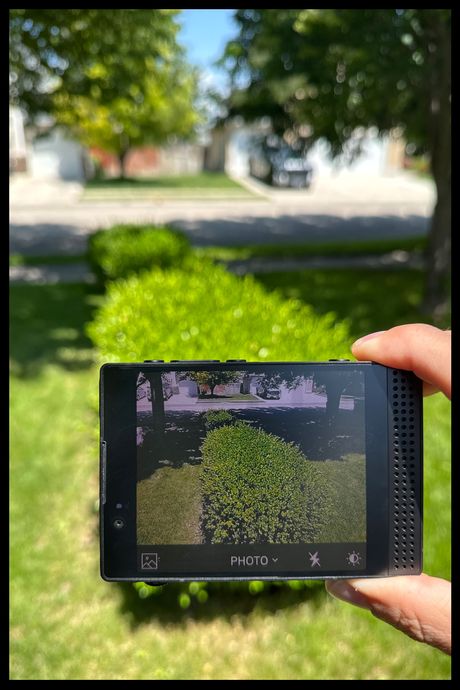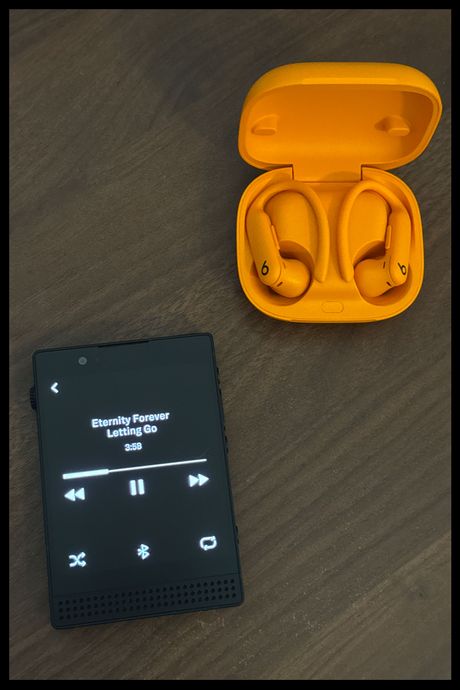
I’ve tried everything short of hypnosis to spend less time on my phone — grayscale mode, app limits, leaving it in a different room like it’s a cursed object. But inevitably, I get sucked into a content black hole and end the day thinking about all the better ways I could’ve spent my time. So I opted to try something more drastic: I made the minimalist Light Phone III my primary phone for two weeks. Since then, I’ve cut my daily screen time down from an average of five hours to three.
It’s somewhere between a smartphone and dumbphone
The Light Phone’s design is jarring at first; it’s shorter and thicker than an iPhone with a matte, e-reader-like display (it’s a type of OLED, so it’s actually more responsive than e-ink) that’s completely uninterested in anything on your “For You” page. When you go to the home screen, you’re greeted with a black-and-white text-based list of all the phone’s apps (there’s no App Store). It’s not a very long list because this phone is designed to offer the most functionality it can without creating any of the distractions that keep us glued to our smartphones.

Although the Light Phone III has a color display, it shows color only when using the camera app. Photo: Jordan McMahon
Almost all of the apps available for the Light Phone come preinstalled when you first set it up. There’s a phone app for making calls and sending messages, note and calendar apps, plus apps for the camera, alarms, podcasts, music, navigation, and a nifty Directory app that works like the Yellow Pages for looking up businesses. There’s also a shortcut to enable the phone’s “Hotspot” mode (also accessible through Settings). Some of those apps have to be enabled and can be managed only through the Light Phone’s web-based dashboard — which you can access only from a tablet, laptop, or smartphone browser — but most of them come pre-enabled. That may sound tedious, but that friction is the philosophy behind it.
The left side of the phone has a dial — sort of like the Digital Crown on the Apple Watch — that you press to turn on the device’s flashlight and rotate to adjust the Light Phone’s display brightness. It’s more convenient than tapping my iPhone’s lock screen to enable its flashlight. On the right side, there are two buttons to adjust the volume as well as camera and home buttons. When you open up the camera or photo app, you’ll see for the first (and only) time that the phone’s display actually has color.
Say good-bye to idle browsing and doomscrolling
When I carry my iPhone with me, every idle moment is an invitation for stimulation — reading an article, checking DMs I’ll probably still forget to answer, scrolling TikTok until my eyes hurt — but that isn’t possible with the Light Phone. I can take a photo and text it to a friend via SMS (it doesn’t have RCS support), but I can’t share it to social media. I can listen to music — but only if I’ve downloaded it locally and then uploaded it to my phone ahead of time. Additionally, I can subscribe to podcasts only from the Light Phone’s web dashboard on my computer.

You can listen to music on the Light Phone III, but you’ll need to upload it from your computer first. Photo: Jordan McMahon
As I carried the Light Phone in place of my iPhone, I often felt the urge to reach for my phone and give my mind something to latch on to, only to face a wall of text-based links to the phone’s limited apps. The Light Phone had no interest in saving me from my boredom — and that was sort of the point.
For instance, my iPhone is my go-to camera, and I often end up posting snapshots of my day to my Instagram Story. I can’t do that on the Light Phone, so instead I’ve taken to sending photos to my sister or close friends when I feel like sharing a nice moment. The image quality isn’t nearly as good as you’d get on an iPhone, Galaxy, or Pixel device. It looks more like an old Polaroid: imperfect, nostalgic, and more private.
I recently moved to a new city, and I still can’t get around without some navigational help. I typically rely on Apple Maps, but since neither that nor Google Maps is available on the Light Phone, I’ve been relying on the company’s own maps app. It works — you can get driving, walking, and transit directions — but it’s extremely limited. It has turn-by-turn directions and voice navigation but no cycling directions, and it doesn’t have the same real-time traffic updates as Apple Maps, Google Maps, or Waze. I used it both in my car and when walking to a bar to meet up with a friend; in both cases, I managed to get to my destination in the estimated time without any trouble. If you want to find a restaurant, bar, or coffee shop to check out, you can’t do so in the maps app. Instead, you have to go to the Light Phone’s separate Directory app. It’s a fine app, but I wish it were directly within the maps app for a tidier experience.
There have been things I’ve missed, though. I can’t access my Spotify playlists, there’s no to-do-list app (though the lightweight notes app is useful), and I don’t have any way to check the news or listen to my audiobooks from Libro.fm without doing some funky DRM removal on another device. I also can’t use my kickboxing gym’s app to sign up for classes, send voice notes to friends, or do a quick web query to settle a debate at the bar. Mostly, that’s a good thing; I can check the news when I’m at my desk, I switched to a paper-based task system, and I’m accepting that not every debate needs to be settled on the spot.
It does have some limitations — but those are the point
I’ve found those setbacks to be beneficial, but eventually I hit a brick wall in my pursuit of ditching my smartphone. I review a lot of gadgets, and many of them require me to use an accompanying app to test out all of their features and integrations with other products and services. While doing a fresh round of testing for our robot-vacuums guide, I had to run back upstairs and grab my iPhone to set up each robot, as there’s no way to do that on the Light Phone. I got around this by keeping my iPhone on Airplane Mode with only my essential apps installed, but that still means carrying two devices around with me everywhere I go.
Most people aren’t testing robot vacuums for a living, but chances are you have a few apps that keep your life stitched together. Maybe it’s your work schedule, or if your company uses a proprietary app rather than Google Calendar. Maybe it’s your kid’s school portal. The Light Phone won’t let you access those things, and if they’re necessary, you may need to keep a laptop or tablet nearby, stick with your smartphone, or use the Light Phone’s Hotspot feature to keep your phone connected for short periods of time. If you can get past those limitations, though, I haven’t found a better tool in getting me to cut down on my screen time.
But it truly does work
At $700, this phone isn’t an impulse buy — it’s a commitment. A lifestyle. It takes a bit of preplanning to figure out what you’re going to listen to on your next outing, and you won’t have access to any work-related apps you might need, like Slack or Google docs (I find the lack of Gmail extremely welcome). But if you’re willing (and able) to give up your smartphone’s conveniences — I’ve replaced mine with a notebook, a camera, and an e-reader — the Light Phone becomes a powerful tool in regaining your time and attention. I don’t pick up my Light Phone as often as I used to pick up my iPhone, but when I do, it’s with intention.
Participate in the 2025 ePaper Global Award for Innovative ePaper Product Collection, please refer to the following: https://inn.epaperia.com/indexen.html








